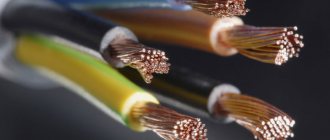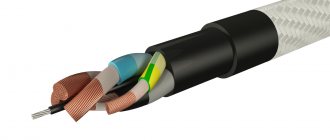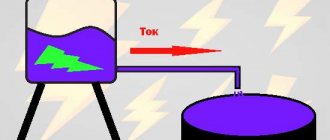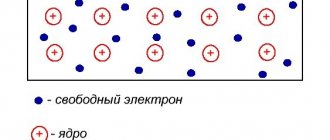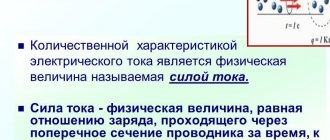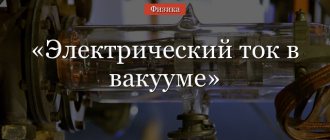Thermal effect of current
Thanks to this action of current, we can illuminate rooms using incandescent lamps. We also use various heating electrical appliances - convectors, electric stoves, irons (Fig. 1).
Rice. 1. These electrical appliances convert electrical energy into heat
Using a meter-long piece of nickel wire (Fig. 2), you can demonstrate the heating of a conductor when an electric current flows through it. To noticeably sag the heated wire due to a thermal increase in length and observe its reddish glow, a current of 2 - 3 Amperes will be sufficient.
Rice. 2. The conductor heats up under the influence of current
A piece of wire heats up when electric current flows through it. The more current in the conductor, the more it will heat up. The length of the heated conductor increases.
You can read more about the amount of heat released in the article about the Joule-Lenz law (link).
Note: Nichrome, nickel, constantan are metal alloys with high resistivity (link). Wires made from such alloys are used in various heating electrical appliances.
How to act when providing assistance in case of electrical injuries
First aid for electric shock consists of a certain sequence of actions:
- free a person from contact with an electrical source. To do this, you must disconnect the unit from the power supply. If for certain reasons this is not possible, special means should be used for emergency shutdown. For example, throw a wire over a power line or cut a cable with an ax. In the process of providing assistance, we must not forget about our own safety - you must not touch open areas of the skin of a person in contact with an electrical source. When an incident occurs when working with equipment up to 1000 V, you can use dielectric materials at hand, for example, a piece of dry wood. It is also permissible to pull a person by the edges of his clothing (if it is not wet). At installations with voltages exceeding 1000 V, special protective equipment is used to provide assistance.
Exemption from the effects of electric current on installations of more than 1000V “A” and up to 1000V “B” - determine the condition of the victim;
- assess the damage caused;
- take actions necessary to save the life of the victim;
- call for medical assistance and support the victim’s vital functions until it arrives.
Chemical effect of current
An electric current passing through solutions of certain acids, alkalis or salts causes the release of a substance from them. This substance is deposited on electrodes - plates dipped into the solution and connected to a current source.
This effect of current is used in electroplating - metal coating of certain surfaces. Nickel plating, copper plating, chrome plating, as well as silver and gilding of surfaces are used.
Using a solution of copper sulfate, you can demonstrate the release of a substance under the influence of current. An aqueous solution of this salt has a bluish tint. By passing an electric current (link) through the solution, you can detect copper precipitation on one of the electrodes (Fig. 3).
Rice. 3. Copper is released from a solution of copper sulfate when current flows, depositing on one of the electrodes
At which electrode will copper be deposited?
Copper in the vitriol solution is present in the form of positive ions. Bodies with opposite charges attract each other. Therefore, copper ions will be attracted to the plate, which has a charge with a minus sign. That is, a plate connected to the negative terminal of the current source. This plate is called a negative electrode, or cathode.
The second plate connected to the positive terminal of the battery is called the anode.
Note: Copper sulfate can be found at a hardware store. Its chemical formula is \(\large CuSO_{4}\). It is used in agriculture for spraying the foliage of fruit trees, shrubs and vegetable crops - for example, tomatoes, potatoes. Included in various solutions used in the fight against plant diseases and insect pests.
Application of the chemical action of current in medicine
The chemical effect of current is used not only in electroplating.
Passing an electric current through solutions causes the movement of charged particles of the substance in them - positive and negative ions. The human body contains fluids in which certain substances are dissolved. This means that such liquids contain ions.
By applying special electrodes moistened with drug solutions to individual areas of the body and passing small currents through them, it is possible to introduce certain medications into the body (Fig. 4).
Rice. 4. Electrophoresis is based on the chemical action of current
This administration of drugs is called electrophoresis and is used in physiotherapeutic rooms of clinics and sanatoriums.
Effect of frequency
From the above formula for the total resistance of the human body, it follows that as the frequency of alternating current increases, the resistance decreases, which leads to an increase in current and an increase in the danger of injury. However, practice shows that this conclusion is valid only within certain frequencies. For a long time it was believed that in the low frequency region the 50-cycle current is most dangerous. With a further increase in frequency within the range of 50 - 400 Hz, the current maintains approximately the same values. Further increase in frequency reduces the risk of injury. But whether it is harmful or not harmful to the human body, there is no affirmative answer yet.
There is a comparative danger to humans from rectified current. The presence of frequency components in it aggravates the outcome of electrical injury. So far this is a little-studied section of electrical safety.
Magnetic effect of current
Copper by itself is not attracted to a magnet. This can be verified using a small magnet and a piece of copper wire (Fig. 5a).
In Figure 5, a piece of copper wire is suspended from two stands using thin threads that do not conduct electricity.
However, during the flow of electric current, the copper conductor begins to interact with the magnet - to be attracted to or repelled from it (Fig. 5b).
Rice. 5. A magnetic field arises around the current-carrying conductor, due to which the conductor interacts with the magnet
It is not the copper conductor itself that interacts with the magnet, but the current flowing through this conductor.
Why does a current-carrying wire interact with a magnet?
An electric current is a large number of electrons running through a wire from one end to the other. Electrons have a charge.
A magnetic field arises around moving charges. Thanks to this, the current-carrying wire turns into a small magnet. And it begins to interact with the magnet, being attracted to it or repelled from it.
At the same time, the wire, as a lighter object, will move. And the magnet will continue to remain in place. Due to the fact that its mass is significantly greater than the mass of a piece of wire.
The direction of movement of the wire depends on the polarity of its connection to the battery and on how the magnet poles are positioned.
The action of an electromagnet is based on the magnetic action of current.
Homemade electromagnet
It is easily made from a piece of flexible insulated copper wire and an iron nail.
The nail must be wrapped in a piece of paper - a sleeve (Fig. 6). Then you need to wind 200 - 300 turns of thin copper wire in insulation onto the sleeve. You need to connect a battery from a flashlight to the terminals of the resulting coil.
Rice. 6. You can make a homemade electromagnet from scrap materials
During the flow of current, various small iron objects are attracted to the nail - paper clips, buttons, nails, iron filings, sawdust, etc.
Having disconnected the battery, we will see that as soon as the current stops, the nail stops attracting iron objects.
Factors influencing the outcome of electric shock
There are several dominant reasons on which the nature of damage during electrical injury depends:
- the strength of flowing, constant or alternating electric current (damage from the latter is more fatal);
- duration of the electric current (the longer it is, the greater the likelihood of severe injury). The figure shows the dependence of damage on exposure time;
Influence of the time factor on the nature of damage - which way the electric current will flow;
Dangerous paths of electricity flow - physical as well as psychological state (affects the resistance of the human body).
Current frame and horseshoe magnet
A wire with sufficient rigidity can be bent into a flat shape - a rectangle, square, circle. Elastic wires are wound onto a rigid frame made of a suitable material - plywood, cardboard, plastic, etc. Such a curved wire forms a frame. A wire frame is often called an outline.
A wire frame through which an electric current flows can be oriented in a magnetic field.
To verify this, let's conduct the following experiment. We use a horseshoe magnet and a conductor bent in the form of a rectangular frame for it. Hang the frame to the tripod leg using a thread. The dimensions of the frame must be chosen so that it fits between the poles of the magnet.
First we use only the suspended frame (Fig. 7a), without a magnet. Let's connect a current source to the frame. You can make sure that after connecting the current, the frame continues to hang motionless. Let's turn off the current source.
Rice. 7. A current-carrying wire frame placed in a magnetic field rotates
Now let's place the magnet so that the frame is between its poles (Fig. 7b) and pass electric current through the circuit. It is easy to notice that during the flow of current the frame rotates and is oriented according to the magnetic field. And when the circuit opens, the frame returns to its original position.
Note: If you change the polarity of connecting the source to the frame, it will rotate in the opposite direction.
The remarkable property of a current-carrying frame to rotate in a magnetic field is used in various measuring instruments. One such device is a galvanometer.
Types of impact
An electric current of 0.5 to 1.5 mA is considered minimal for human perception; when this threshold value is exceeded, a feeling of discomfort begins to appear, which is expressed in involuntary contraction of muscle tissue.
At 15 mA or more, control over the muscular system is completely lost. In this state, it is not possible to break away from the electrical source without outside help, therefore this threshold value of electric current is called unreleased.
When the electric current exceeds 25 mA, paralysis of the muscles responsible for the functioning of the respiratory system occurs, which threatens suffocation. If this threshold is significantly exceeded, fibrillation occurs (heart rhythm failure).
Video: the effect of electric current on the human body
Below is a table showing the permissible voltage, current and time of their exposure.
Permissible voltage, current and time of their exposure
Electrical injuries can result from the following types of impacts:
- thermal, burns of varying degrees appear, which can disrupt the functioning of both blood vessels and internal organs. Please note that the thermal manifestation of the action of electric current is observed in most electrical injuries;
- electrolytic effects cause changes in the physical and chemical composition of tissues due to the breakdown of blood and other body fluids;
- physiological, leads to convulsive contractions of muscle tissue. Note that the biological effect of electric current also disrupts the functioning of other important organs, such as the heart and lungs.
Galvanometer device
The device was named galvanometer in honor of the Italian physicist and physician Luigi Galvani. This device is capable of measuring small electrical currents (direct).
On diagrams, the device is designated by a circle, inside of which there is a large Latin letter G. On some diagrams, inside the circle there is an arrow pointing vertically upward.
Galvanometer contains:
- horseshoe magnet and
- a frame located inside it containing turns of thin copper wire (Fig. 8).
Rice. 8. How the galvanometer is tripled
The movable frame is located on an axis and can rotate around it.
An arrow is attached to the frame. It indicates at what angle the frame rotated while electric current flowed through it.
The angle of rotation is marked by scale divisions.
Rice. 9. What does a device for measuring small currents look like?
Who is Luigi Galvani
Galvani was one of the founders of the doctrine of electricity.
I discovered that electrical voltage occurs at the points of contact between different types of metals.
Conducted experiments using an iron key and a silver coin.
He studied muscle contractions under the influence of electricity and came to the conclusion that muscles are controlled by electrical impulses traveling along nerve fibers from the brain.
In the Italian city of Bologna, not far from the building of the University of Bologna, there is a monument to Galvani. It is located in Piazza Luigi Galvani, named after the scientist.
One of the craters on the far side of the Moon was also named in his honor.
And the Bologna Lyceum has been named after Galvani since 1860.
About magnetoelectric system devices
Such devices, containing a conducting frame and a small magnet, are called magnetoelectric system devices. They are widely used due to their relatively simple design.
Instrument scales can be graduated in various units of measurement, depending on the physical quantities being measured. Based on such devices, voltmeters, ammeters, ohmmeters, etc. are made.
Types of electrical injuries
Exposure to electric current causes the following characteristic damage:
- Electrical burns can occur due to the passage of electric current or be caused by an electric arc. Note that such electrical injuries occur most often (about 60%);
- the appearance of oval gray or yellow spots on the skin where the electric current passes. The dead layer of the skin becomes rough, and after some time such a formation, called an electric sign, disappears on its own;
- penetration of small particles of metal (melted from a short circuit or electric arc) into the skin. This type of injury is called skin metallization. The affected areas are characterized by a dark metallic tint, touching it causes pain;
- light action causes electroophthalmia (inflammatory process of the eye shell) due to ultraviolet radiation characteristic of the electric arc. For protection, it is enough to use special glasses or a mask;
- mechanical impact (electrical shock) occurs due to involuntary contraction of muscle tissue, which can result in rupture of the skin or other organs.
Note that of all the electrical injuries described above, the greatest danger is the consequences of an electric shock; they are divided according to the degree of impact:
- cause contractions of muscle tissue, while the victim does not lose consciousness;
- convulsive contractions of muscle tissue, accompanied by loss of consciousness, the circulatory and respiratory systems continue to function;
- Paralysis of the respiratory system and cardiac arrhythmia occur;
- the onset of clinical death (there is no breathing, the heart stops).
Answers
Electromagnetic induction. Faraday's experiments. Electromagnetic oscillations and waves →
← Work and power of electric current. Joule-Lenz law
Oersted's experience. Magnetic field of current. Interaction of magnets. The effect of a magnetic field on a current-carrying conductor
2.8 (55.41%) 109 votes


